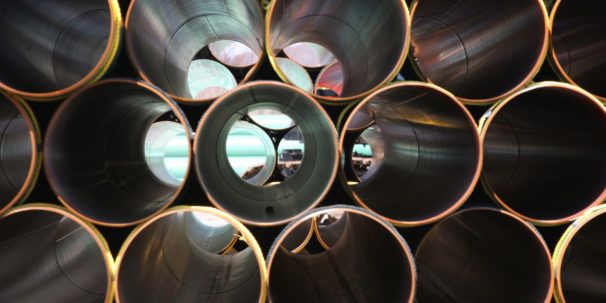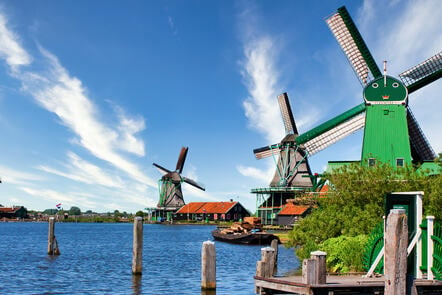The Keystone XL Pipeline: Why did its Canadian owners abandon it?
The Keystone XL Pipeline was a pipeline extension for transporting oil sands from Alberta to the US. Why was it so controversial, and why did it get cancelled?

Why was the Keystone XL Pipeline abandoned?
The Keystone XL Pipeline, often abbreviated as KXL, has been the topic of many headlines in the past decade. This culminated in the project finally being abandoned after US President Joe Biden cancelled its permit on the first day he took office.
What was meant to be a step in further developing Alberta’s oil sands invited protests from environmental organisations, Indigenous groups and other stakeholders. The cancellation of the permit was seen as a win for those fighting against climate change, and a step towards a policy that will ensure a sustainable future.
What was all the controversy surrounding the Keystone XL Pipeline about, and how did Canada play a part in this? Here, we take a look at the history of this contentious pipeline, major factors in its development and why, after a lengthy and well-publicised battle, the Keystone XL Pipeline was ultimately abandoned.
Canada’s relationship with Oil
Although the Canadian government under Justin Trudeau has committed to combating climate change through several new policies and regulations, Canada hasn’t always had a happy relationship with the environment.
In fact, Canada’s relationship with oil and gas has long exceeded its commitments to renewable energies and bettering the environment. Here is an overview of oil and gas in Canada, from its history to the foreseeable future.
A brief history of oil and gas in Canada
The history of oil and gas in Canada is intertwined with the development of Canada as a nation. The first discovery of oil in Canada was in 1858, in southwestern Ontario, which led to the first extraction of oil for commercial use in Canada.
In 1904, oil was discovered in Medicine Hat, and in 1914 it was found in Turner Valley. Then in 1947, the Leduc oil fields were discovered. All three of these discoveries took place in the province of Alberta. Today, oil continues to be Alberta’s biggest export.
Oil was discovered through oil seeps on the ground coupled with exploratory drilling. It was known in the 19th and 20th centuries that oil was important for domestic and industrial use, and the valuable substance meant jobs and settlements were created in order to exploit the natural resources of the land.
Today, most of Canada uses hydroelectric energy, but about 18% of the energy used is from nonrenewable sources, including coal and gas. This number is set to decline as the impact of climate change has led to the implementation of regulations and policies that support renewable energies in lieu of burning fossil fuels, including lower emission vehicles and alternative methods of heating homes.


What’s next for oil and gas
Because of Canada’s commitment to adhere to the Paris Agreement and lower emission rates to 30% below what it was in 2005, many measures have been implemented in order to curb emissions. That means consumption of gas and oil products will likely decrease in the coming years.
However, this does not directly affect the oil and gas that is destined for export. In this way, even though Canada as a nation will emit less carbon directly into the air, we will still contribute to the global amount of pollution emitted for the sake of profit.
The downside to the transition away from gas and oil is that there are many who are trained in the industry who will see their jobs being taken away as the need for non-renewable fuels decreases.
One measure that addresses this is the Just Transition for Canadian Coal Power Workers and Communities Task Force, which produced reports that will inform plans to help create a smooth transition for workers to come away from the coal industry.
Crude oil vs coal vs oil sands
When speaking about oil and gas, some terms are seemingly interchangeable, but each one refers to a specific type of natural resource.
What is crude oil?
Crude oil, otherwise known as petroleum, is the raw substance that is extracted from the earth, which is then usually refined and processed into various types of fuels. These fuels include the petroleum product by the same name that is processed and used in motor vehicles.
Other products derived from crude oil include diesel, LNG, jet fuel, propane, kerosene, biofuels as well as plastics, ammonia and other sterilising liquids. Crude oil is a fossil fuel that is composed of hydrocarbons and organic compounds, formed from huge quantities of dead organisms that have been buried under sedimentary rock formations.
Through intense heat and pressure and formed over millions of years, these oils can be found in nature reserves around the world.
What is coal?
Coal is similar to crude oil in that it too is formed through geological forces over a period of millions of years. The difference is that coal contains a much higher carbon content, and is in solid form. Because of this, the burning of coal produces more carbon emissions than petroleum and other types of fossil fuels.
What are oil sands?
Oil sands, on the other hand, are considered an unconventional petroleum deposit. Also known as tar sands, crude bitumen, or bituminous sands, it consists of sand, clay, water and bitumen. Bitumen is also known as asphalt, a dark, extremely viscous substance that has been used in ancient times as a means of waterproofing, as an adhesive, embalming and more.
One of the largest deposits of this substance is in the Athabasca oil sands in Alberta. This substance is what the Keystone XL Pipeline would have been transporting from Alberta through Montana to join the existing parts of the pipeline in Nebraska.
Other forms of unconventional deposits include oil shale, which is found in sedimentary rock.




What is the Keystone XL Pipeline?
The Keystone Pipeline System is an oil pipeline system that runs between Canada and the United States. It was commissioned in 2010 and was to have four phases. Three of the phases have now been completed, while the fourth one, an extension known as the Keystone XL (which stands for Keystone export limited), was cancelled in 2021.
The history of the Keystone Pipeline prior to the XL extension
In 2005, the pipeline was first proposed by TransCanada Corporation (now known as TC Energy Corporation), and in 2007, it was approved by the National Energy Board of Canada. It was meant to run from the Western Canadian Sedimentary Basin, starting at Hardisty, Alberta, to refineries in Illinois and Texas. Other destinations include distribution facilities in Oklahoma.
Not long after it was approved in Canada, the Communications, Energy and Paperworkers Union of Canada requested that the pipeline be blocked, as the pipeline would only serve US markets, hindering job creation and investment in energy for Canadians.
The pipeline was issued a permit for construction by then-President George W. Bush, during his final year of presidency in 2008.
The first phase of the pipeline took two years to acquire all necessary permits and another two years to build. It became operational in June 2010. During this time, the pipeline continued to be criticised by the Environmental Protection Agency and other environmental groups, but the construction of the pipeline continued.
In February 2011, the Keystone-Cushing extension, which was Phase II of the pipeline, was completed. Three years later, in 2014, Phase III of the pipeline, which was called the Gulf Coast Extension, was also completed.
The Keystone XL Pipeline Extension
The Keystone XL extension, which was Phase IV of the Keystone pipeline, was originally proposed in 2008, two years before Phase I was completed. In 2012, then-President Barack Obama endorsed the building of Phase III, but in 2015, after Phase III was completed, he vetoed the bill that approved Keystone XL.
An attempt to override the veto failed when brought to the Senate, who were a few votes short of a necessary two-third majority. The project looked as though it would be abandoned, with then US Secretary of State John Kerry stating that the project was not in the public interest due to the damaging perception of it potentially increasing greenhouse gas emissions.
In November of 2015, the Obama administration rejected the Keystone XL extension for both economic and environmental concerns. But later on, in January 2017, former President Donald Trump signed a presidential memorandum during his first week of office which revived the Keystone XL pipeline project. In March 2017, he signed the permit to allow TransCanada to build the pipeline.
Later that year, the Nebraska Public Service Commission approved its construction, but via an alternate route to the ones that were originally proposed. This new route was longer and evaluated as having less of an environmental impact.
The construction was to begin in 2020, but it was suspended after it was alleged that the project was improperly reauthorized in 2017 because it violated the Endangered Species Act. On July 6 2020, the US Army Corps of Engineers v. Northern Plains Resource Council case was lost by the former party, which saw that the Keystone XL pipeline project halted construction.
In January 2021, President Biden revoked the permit. Then, on June 9th of this year, the project was cancelled.
Why was the Keystone XL Pipeline proposed?
The Keystone Pipeline was originally proposed to transport the oil from the Athabasca oil sands in Alberta to various locations in the US. There were many pros and cons for Keystone XL, and experts on both sides had strong arguments for the time period.
The Keystone XL extension would increase the capacity of tar sand oils by 830,000 barrels to refineries in Texas at a time when oil prices were exceptionally high. It would also act as a shortcut, providing faster and cheaper fuel to areas of need.
Although the initial Keystone Pipeline already ran from Alberta to Texas, its route was much longer. The proposed extension would cut through Montana and South Dakota to join the existing pipeline at the edge between Nebraska and Kansas, stretching across 1,897 kilometres.
Those that were in favour of this pipeline expressed that it would create jobs and boost the economy. There are already several pipelines transporting oil and gas throughout the US and the industrialised world, and adding a new one may not have seemed particularly controversial.
However, the difference between the existing pipelines and the Keystone Pipeline is its contents. While other pipelines carry unrefined petroleum, the Keystone Pipeline is made to transport tar sands, a relatively new source of fuel with different physical properties.
Tar sands have been found to be thicker and more acidic than conventional oils, which leads to more corrosion and difficulty in transporting it.
Why was the Keystone XL pipeline extension cancelled?
The Keystone Pipeline faced several critics from its initiation. Environmental organisations, Indigenous groups, landowners and other interested citizens all voiced their concerns. Most of this was around environmental issues, some of which led to issues with the legal process under which permits were acquired. Other issues involved land ownership and job security.
The Keystone Pipeline leaks and spills
From 2010 to 2011, the pipeline had several small leaks of up to 600 litres before it spewed over 90,000 litres (20,000 gallons) of oil onto private land in North Dakota on May 7, 2011. A few weeks later, on May 29, 2011, it leaked a further 63,600 litres at a pumping station in southeastern North Dakota.
TransCanada claimed that the latter should not count towards their spill estimates because pumping station spills are not part of the tally. Regardless, the Pipeline Hazardous Materials and Safety Administration (PHMSA) of the United States issued a Corrective Action Order to fix these two leaks. But the leaks were far from over.
In the following years, smaller leaks were found throughout the pipeline. In 2015, it was discovered that corrosion of the pipeline was happening at an alarming rate, where after two years of operation, one spot was already 95% worn.
Then, in 2016, nearly a million litres of oil was leaked from the original Keystone pipeline in South Dakota, caused by faulty welding. The PHMSA issued another Corrective Action Order, and TransCanada released plans to replace parts of the pipeline that were deemed to be not up to standard.
But on November 16, 2017, about twice the amount of the previous leak spilled onto farmland in South Dakota, totalling more than 1.85 million litres. Another Corrective Action Order was issued. In 2019, another estimated 1.7 million+ litres of oil spilled, with portions in Missouri and the majority in North Dakota.
The environmental impact of the Keystone Pipeline
There are many environmental issues with the Keystone Pipeline, stemming from the leaks and beyond:
- Those who come into contact with the oil sands due to the leaks, both human and wildlife, will suffer injuries or even fatalities. In the short term, these oils can lead to fire hazards or explosions. In the longer term, they contaminate water supplies and affect local ecosystems, making the land inhabitable.
- Along with the costly clean up of these spills, the run-off into bodies of water significantly harms aquatic habitats as well as the livelihoods of Indigenous populations that rely on these lands and waters.
- In addition to being more corrosive, tar sands oil is more difficult to clean up than conventional crude oil. Because the bottom line of the project is for the sake of corporate profit rather than job creation or making energy available, as oil and gas lobbyists claimed, cutting corners in order to reduce costs is inevitable.
- Even if there are no spills, the fact of the matter is that the oil sands will be burned as fuel at some stage, turning into carbon emissions that contribute to global warming.
Regardless of its final destination, whether it ends up in a car tank in the US or sold for profit elsewhere in the world, the life of these oil sands, which begins with extraction in Alberta, will end either in a leak that harms local ecosystems or in the atmosphere, advancing climate change.




Legal battles around the Keystone XL Pipeline
Since it was initially proposed in 2005, the Keystone Pipeline faced many legal hurdles, with the XL extension being the most contentious of all. Here are some of the main legal happenings surround the Keystone XL Pipeline:
- Legislators wrote to their governments for more environmental accountability and scientists began speaking up. In response, the State Department extended its review of Keystone XL for another year.
- Protestors campaigned at the White House and Parliament Hill, and the State Department then directed TransCanada to reroute the XL extension to avoid the ecologically sensitive region in Nebraska.
- When President Obama rejected their proposal, a new route was submitted for the Southern leg of the extension in Nebraska. Nebraska approved this new route in 2013, but a lawsuit against Nebraska was filed and won in 2014.
- An executive order was signed to approve Keystone XL. However, the construction was again blocked by a federal judge. In March 2019, Trump issued a presidential permit for the extension. Construction officially began in April 2020.
- When President Biden came into office, the plans were once again rejected. On June 9, 2021, the Keystone XL pipeline was officially cancelled by TC Energy, formerly TransCanada.
Other issues with the Keystone XL Pipeline
Besides the legal battles and environmental debates, Keystone XL has also opened up discussion in other areas.
This pipeline became a game of political ping pong between the US Democrats or Republicans that were elected into office, with cancellations and approvals recurring throughout the process.
At some point, residents had to wonder whether the issue was really based on the environment and the economy rather than a way to flex political power. It is, however, an interesting look into how changeable policy and regulation can be with the quick transitions between those who hold office.
Although often poised as a battle between the economy and the environment, the economy is a human-made phenomenon. Even though it would have been boosted temporarily with the addition of this pipeline, it can also be manipulated and boosted by other means.
For example, investment in renewable energies means that new innovations in green solutions result in a boosted economy and jobs created in this sector. Being married to a single industry for the sake of the economy is to misunderstand the dynamic ways an economy can evolve to fit human needs.
The jobs created by the construction of the pipeline would also be short-term, meaning it would be a temporary boost to the economy that would not be sustained once the pipeline is complete.
There are those who claim that pipelines are a safer method of transporting fuel and that it gives the possibility of exploring other areas for energy sources, such as the arctic, where roads are difficult to build. However, these arguments are short-sighted.
They are premised on the idea that transportation of non-renewable energy sources is a necessity, when the safest method of transportation would actually be no transportation of non-renewable energy at all. The focus should instead be on a transition towards renewable energy sources, welcoming innovations in every area from transport systems to homes.
Final thoughts
There are a few possible takeaways from the story of the Keystone XL pipeline extension. One is that organising and calling to attention the issues that will harm the planet at large can have positive outcomes. This should be remembered when faced with current situations of a similar calibre, such as that of the Canadian oil distribution company Enbridge who are currently attempting to build another tar sands pipeline.
Another is that although oil and gas are historically important to the development of Canada, industry and economy is continually evolving, and as we understand more about the impacts of industrial activity, the transition towards more sustainable methods of living is inevitable and often for the better.There are ways for the economy and the environment to work together in order to produce a more sustainable future, and corporate profit losses are nothing compared to what could be lost if the battle for the environment is forfeited. The cancellation of the Keystone XL pipeline extension is a good win for the environment, but it is nowhere near its last.





